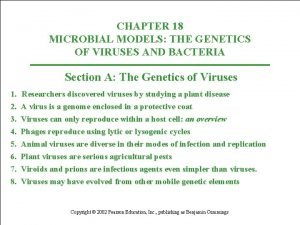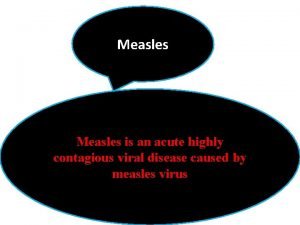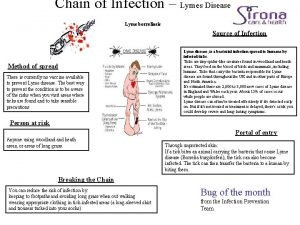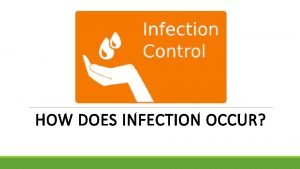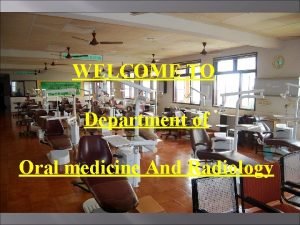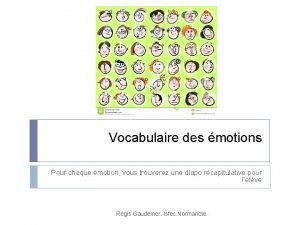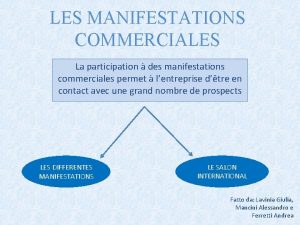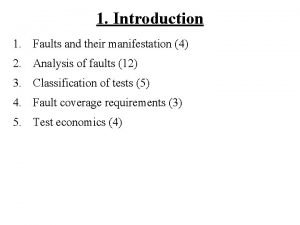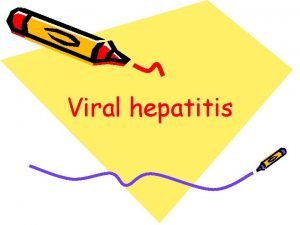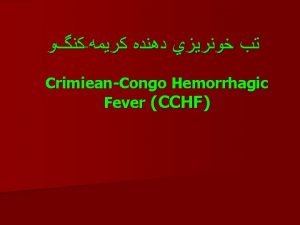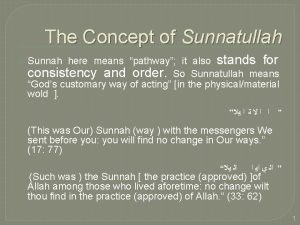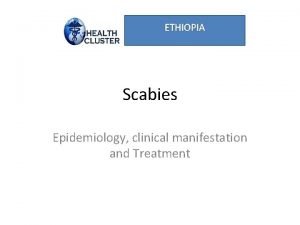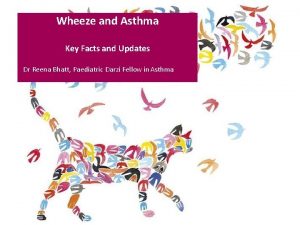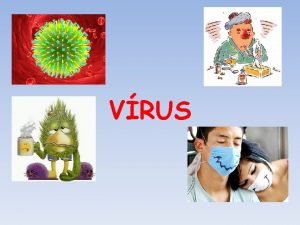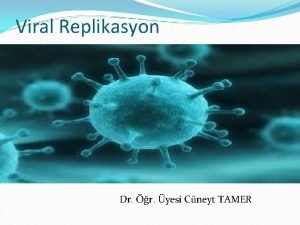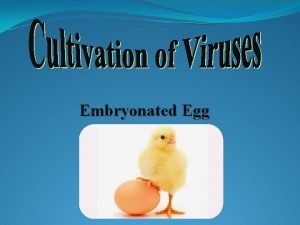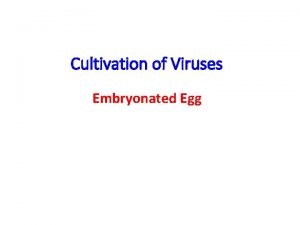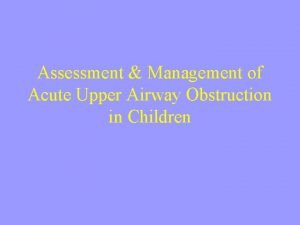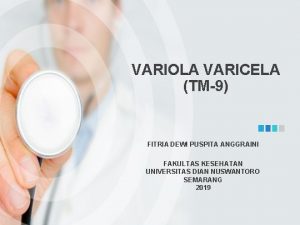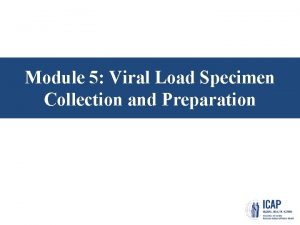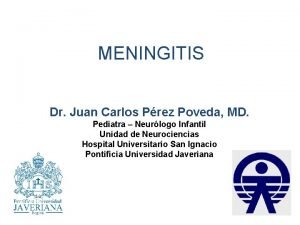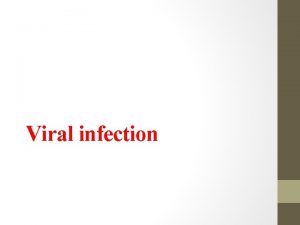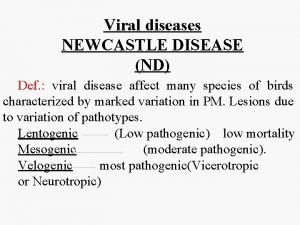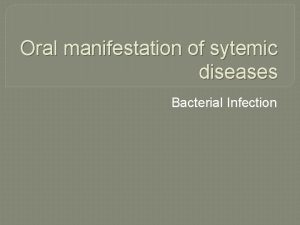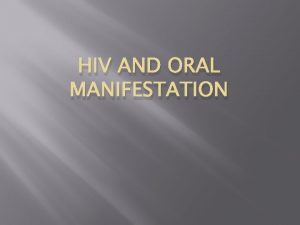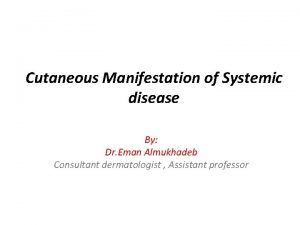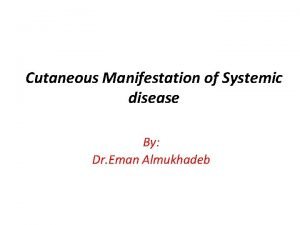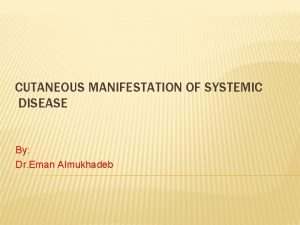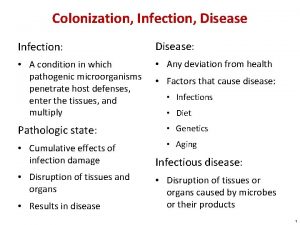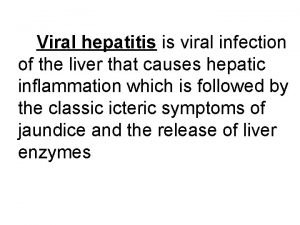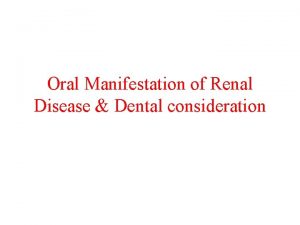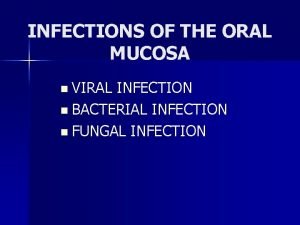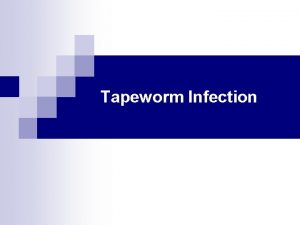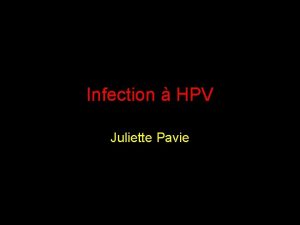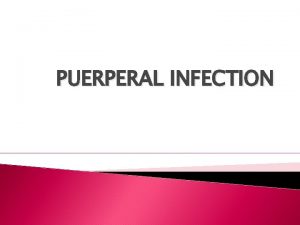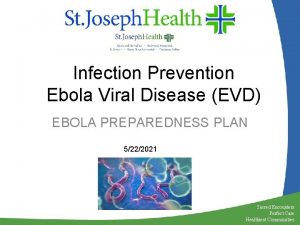Oral manifestation of systemic disease viral infection Introduction







































- Slides: 39

Oral manifestation of systemic disease viral infection

Introduction � Viruses have been defined as submicroscopic entities which reproduce within the specific living cells. � Virus may contain either RNA or DNA. Classification RNA Virus like Influenza virus, Measles, Mumps, Coxsackie virus, common cold, Foot and Mouth disease

DNA Virus � Herpes Virus • Herpes Simplex II • Herpes Zoster • EBV • Cytomegalovirus • Human herpes virus -8 � Pox Virus � Adeno Virus

� Viral diseases typically have an acute or abrupt onset of multiple lesions. � Systemic manifestations (including fever, malaise, lymphadenopathy, diarrhea, lymphocytosis) may be present. � It is important to realize, however, that not all patients with viral diseases have systemic manifestations.

Herpes Simplex Infection � Most common viral infection affecting human � Initial infection acquired from eyes, skin and mucosa with infected secretion. � (HSV) types 1 and 2 commonly infect skin and oral mucosa. Type 1 preferentially involves mucosa and skin above the waist, while type 2 usually infects the genital area, but occasionally the pattern is reversed. Individuals infected with HSV will harbor latent virus in regional nerve ganglia for the remainder of their lives. � Primary symptomatic infection with HSV involving the mouth is called primary herpetic gingivostomatitis. Although primary herpes is most common in children, it can certainly occur in older adults without antibody to HSV.

IMAGES OF PRIMARY HERPETIC GINGIVOSTOMATITIS

� Clinically, HSV-1 infections begin with prodromal symptoms of fever, loss of apetite, malaise and myalgia. � Within few days of prodromal symptoms, erythema and clusters of vesicles and/or ulcers appear on the hard palate, attached gingival and dorsum of tongue and nonkeratinised mucosa of buccal and labial mucosa, ventral tongue and soft palate. 3 6 � Vesicles break down to form ulcers that are usually 1– 5 mm and coalesce to form larger ulcers with scalloped borders and marked surrounding erythema. � The gingiva is often fiery red, and the mouth is extremely painful, causing difficulty in eating. � Tender lymphadenopathy of the head and neck

Diagnosis and treatment � It is important to distinguish primary from recurrent herpetic infection. � patients with a secondary infection will recall previous episodes of vesicular eruptions on their lips. Treatment modalities include � Nutritional supplements. � Analgesics such as acetaminophen to manage the associated pain and malaise. � Antiviral drugs: Acyclovir: in cream or as oral suspension administered in a rinse and swallow technique. Valacyclovir: increase the bioavailability of acyclovir by 3– 5 times. Famciclovir: the oral prodrug of penciclovir has an oral bioavailability 3– 5 times that of acyclovir.

Pharyngotonsillitis � HERPES simplex virus (HSV) type 1 is now recognized as a common nonbacterial cause of acute pharyngitis in young adults � Sore throat, Fever, Malaise & Headache. � Numerous vesicles develops on the tonsils & posterior pharynx. � Vesicles ruptures to form ulcers which coalsce

HERPES GLADIATORUM � Also known as herpes rugbiorum or "scrumpox"[(after rugby football), "wrestler's herpes" or "mat pox" (after wrestling). � it is one of the most infectious of all herpes-caused diseases. � This skin infection is spread by direct skin-toskin contact. Sports that involve close contact, such as rugby and wrestling, may spread the infection from one affected athlete to another. � Generally, symptoms usually begin within about 8 days after exposure to an infected person.

Ø A tingling feeling at an affected area, and Ø A cluster or clusters of clear, fluid-filled blisters that are typically surrounded by red skin. Ø The blisters may or may not be painful.

Herpetic Whitlow Ø Herpetic whitlow is a lesion on a finger or thumb caused by either HSV type 1 or 2 during primary infection. Ø The condition is usually seen in children and young adults. Ø In children, it tends to co-occur with gingivostomatitis aphthosa. Ø Oral secretions are a source of infection, so, among adults, health care workers and athletes engaging in contact sports (e. g. , rugby players or wrestlers) are at risk for viral exposure. Ø The clinical picture typically consists of grouped vesicles or ulcers on an erythematous base.

HERPETIC WHITLOW IN PATIENT SUFFERING WITH PRIMARY ACUTE HERPETIC GINGIVOSTOMATITIS

DIAGNOSIS AND MANAGEMENT � But additional analyses (e. g. , polymerase chain reaction enzyme-linked immunosorbent assay) may be required for a definite diagnosis. � Herpetic whitlow should be distinguished from other infectious diseases (e. g. , bacterial whitlow) because of the different treatments required. � Antiviral medication has been widely accepted as effective in reducing the duration of symptoms in primary infection and in recurrent episodes. Symptoms include � Fever, � Swollen glands,

RECURRENT HERPETIC LESIONS � After primary infection, the virus ascends sensory axons via retrograde axonal flow, replicates, and establishes latency within the trigeminal ganglion. � During latency, there is down-regulation of the replicative process, infectious virus and viral antigens are not detectable, and the virus evades immune surveillance. � When an appropriate trigger occurs the virus reactivates, replicates in the ganglion, and travels centrifugally along the axon to the skin or mucosal site. � This is the “ganglion theory” of reactivation. There, it is directly cytopathic to the epithelial cells resulting in vesicles and ulcers

Preciptating factors § Ultraviolet Radiation, § Mechanical Trauma, and § Immunosuppression. Ø Reactivation of HSV can occur as asymptomatic shedding in secretions such as saliva, or the development of clinical lesions that will be termed recrudescent HSV here. Ø Shedding of HSV-1 has wide variability and was noted in 1% to 25% of days when oral swabs were taken. 6 Ø Shedding over a 1 -week period before and after dental treatment was reported to range from 8. 3% to 10. 3%. Ø Asymptomatic shedding occurs more frequently than previously thought.

Ø Recurrent herpes has vesicles and ulcers occurring on keratinized mucosal surfaces. Ø The lesions are grouped in a tight cluster. Ø Often a sudden prodrome of pain, tingling, or numbness precedes the onset of lesions. Ø The frequency of recurrence varies with the individual. Ø Resolution of lesions varies from one to several weeks but is constant for each person.

Management Primary herpes simplex infection Symptomatic • Pain control measures Ø Topical anesthetic like 2% lidocaine , 0. 1% diclonine hydrochloride, 0. 5% benzocaine hydrochloride • Topical antimicrobial agent Ø To prevent secondary infection . Ø Agent like 0. 2% chlorhexidine gluconate, tetracycline mouth wash and diphenylhydramine • Supportive care Ø Fluid is given to maintain proper hydration and electrolyte balance

Specific Treatment � Acyclovir - Inhibits DNA replication • Optimal oral dose 1000 -1600 mg daily for 7 -10 day Recurrent herpes simplex infection Ø Minimized obvious trigger Ø Topical antiviral medication Ø Topical ammonium chloride Ø Systemic antiviral medication

Varicella Zoster Infection � Varicella-zoster virus (VZV), also known as Human Herpes Virus III (HHVIII), is a member of the herpes virus group. � After entering the body and causing primary infection, varicella-zoster virus remains latent in the neurons of sensory ganglion, especially dorsal roots of ganglion of the spinal nerves and extramedullar ganglion of the cranial nerves. � Reactivation of the VZV infection is easily triggered by immune suppression. � VZV infection is common in elder persons, immunocompromised or HIV positive individuals, and patients affected by malignant blood dyscrasias, malignant tumours, or undergoing immunosupressive therapy and radiotherapy.

Various presentation of VZ Infection � Chickenpox (varicella) � Shingles (Herpes Zoster ) � Postherpetic Neuralgia � James Ramsay Hunt Syndrome Oral manifestation of Chicken Pox Ø Small blister like lesions occasionally involve the oral mucosa , tongue, gingiva as well as palate. Ø Mucosal lesion starts as small raised vesicle that reputures soon to form small eroded ulcer with red margins resmbling apthous ulcer

Clinical manifestations of Herpes zoster � Herpes zoster (HZ) in the oral cavity results from the involvement of second and third branch of the trigeminal nerve. � HZ develops 2 -4 days after prodromal period, manifesting itself with general symptoms, such as fever, weakness, fatigue, and neck stiffness. Paresthesia and burning sensation in the region of the affected nerve are also frequent consequences of the VZV infection. � Characteristic sign of oral HZ is the presence of unilateral vesicles that break rapidly, leaving small ulcers. � On skin and lips, vesicle rupture can result in erosions covered by pseudomembranes and haemorrhagic crusts. � Oral lesions without facial skin involvement are rather infrequent.

� Crusts and pseudomembranes, developing during the first week of vesicle formation, usually disappear in the second or third week. � The patient is contagious from 48 hours before vesicle formation, until oral lesions heal. � It is possible that HZ occurs without lesions ("herpes sine herpete" zoster without eruptions),

Postherpetic Neuralgia � A frequent complication of HZ infection is postherpetic neuralgia (PHN). � If pain persists at the site of healed rash or vesicle for more than 6 months it is known as postherpetic neuralgia (PHN). � It affects mkore commonly the older age group patient. � PHN, which is not correlated with immune suppression, is characterised by pain, paresthesia, hyposthesia or alodynia and can persist for months and year. Neuralgic pain is frequently associated with sensory loss. � Neuralgic pain is frequently associated with sensory loss.

James Ramsay Hunt Syndrome � Ramsay Hunt syndrome is defined as an acute peripheral facial neuropathy associated with erythematous vesicular rash of the skin of the ear canal, auricle , and/or mucous membrane of the oropharynx. � Although Ramsay Hunt syndrome is traditionally defined as zoster oticus and lower motor neuron facial palsy, Hunt noted other regular symptoms and signs such as tinnitus, hearing loss, nausea, vomiting, vertigo, and nystagmus. � He explained these eighth nerve features by the close proximity of the geniculate ganglion to the vestibulocochlear nerve within the bony facial canal.

DIAGNOSIS � Based on clinical manifestations and subjective symptoms. � Presence of the viral antigens as well as presence of antibodies against VZV. � Differential diagnosis of other viral infections is also possible so this infection must be well documented. � The best laboratory diagnostics are PCR and direct VZV identification in the cell culture of human fibroblasts. � The sample should be taken from vesicle or serum. � The presence of VZV is evidenced by direct immunofluorescence of antibodies against VZV from the vesicle. and � Up to 80% of the VZV infections could be detected using this method.

� Serological findings are helpful in recurrent VZV infections � It show increased Ig. M, ten days after eruptions and increased Ig. G and Ig. A four days after the eruptions. Serological tests which reveal antibody titers might be useful in immunocompromised patients. Management Herpes Zoster Ø Therapeutic regimens is effective when they are applied 48 -72 hours after the appearance of the oral lesions. Ø Systemic intake of antiviral agents is urgent in the patients who are Ø Older than 50 years of age, Ø In immunocompromised, and in all patients with infection of the head and neck region, especially in those with HZ of the ophthalmic branch.

Acyclovir, valacyclovir, famciclovir or brivudin must be administered systemically. Valacyclovir is proven to be more efficient when compared to the acyclovir. Ø Systemic use of the antiviral drugs shortens the healing period and lessens the pain symptoms together with prevention of other acute and/or chronic complications. In adult immunocompetent subject of less than 50 years of age Ø Symptomatic treatment is generally sufficient Treatment of PHN Ø usually comprises of analgesics together with neuroactive agents as well as with antiviral drugs. Ø Corticosteroids administered systemically during the first two weeks of the disease are helpful in the PHN prevention, but they should not be given when PHN is already present. Ø While treating neuralgia, analgesics, neuroactive agents and B vitamin complex should be administered. Ø

Coxsackie Virus Infection Coxsackie viruses are RNA retrovirus � Two subgroups v Type A- 24 types v Type B-6 types Mode of Transmission of the Virus � • The infection is highly contagious and is spread by horizontal transmission from a child to another child and from a mother to the fetus. • The spread occurs through Ø A direct contact with mucous, oral or nasal secretions, Ø Feces of an infected person.

Hand, foot and mouth disease � It is usually seen in young children mostly younger than five years of age. � It is caused by enterovirus Coxsackie A 16 and has been reported to be caused less commonly by types A 5 and A 6. CLINICAL FEATURES � This viral infection predominantly affects children younger than 5 years of age. � After a short incubation period, (2 -10 days) the sign and symptoms of disease will appear � Signs and symptoms are usually mild to moderate in intensity and include v Low-grade fever, v Malaise, v Lymphadenopathy and Sore Mouth.

� Pain from oral lesions is often a patient's chief complaint. � It is common for the Coxsackie virus to cause a febrile upper respiratory tract infection with a sore throat with or without a runny nose. � Skin rashes are not contagious, resemble a light sunburn appearance. � Sometimes the rashes appeared like small, tender blisters on the palms, soles of the feet, and inside the mouth including the tongue, gums, and the cheek. � This condition is known as a hand-foot-mouth disease (HFMD)

� Vesiculobullous lesion are generally localized in the perioral and perinasal areas of the face, but also on the scalp. � Palmar purpuric macula is a typical feature in adult patients and it is the clinical expression of vesicles more deeply located in the epidermis, probably due to the greater thickness of the palmoplantar epidermis. � In children, the disease usually presents with vesicles or ulcers in the oral cavity occurring chiefly on the buccal mucosa and tongue with few sores around the soft palate, tonsils and also blisters in the hands, feet, and buttocks. � This illness is commonly mild, and approximately all people improve in 7– 10 days without medical treatment.

Ulcers on the palate with an erythematous halo Cutaneous lesions on the dorsal surface of the feet

Diagnosis Clinical Diagnosis Oral lesion in association with skin lesions Differential Diagnosis Ø Herpetic gingivostomatitis Ø Varicella Zoster Infection Ø Herpangina Ø Allergic stomatitis

Herpangina � Also known as Apthous Pharyngitis � It is usually caused by coxsackie A 16 virus and is highly contagious. Other common coxsackie A viruses isolated from herpangina are A 1 -10, 12 and 22 � Most common age 3 -10 yrs � Incubation period 2 to 10 days � Prodormal symptoms- Fever , chills, headache, anorexia, abdominal pain , sore throat, dysphagia. � Lesion starts as punctate macule which develops into papules and vesicles � Witghin 24 -48 hours veicle ruptures to form small ulcerwith gray base and inflammed periphery � Generally heals without treatment in a week

Diagnosis Clinical Diagnosis Ø No specific test is required for dianosis. Ø The diagnosis is based on clinical presentation of the condition Ø Presence of lesions in posterior part of oral cavity. Differential Diagnosis Ø Primary herpes simplex infection Ø Herpes Zoster

Acute Lymphonodular Pharyngitis � Caused by Coxsackievirus A 10. � Zahorsky' described a febrile disease in children characterized by minute vesicles and ulcers in the throat. � It was first named as herpetic sore throat but later changed to herpangina. � This condition is seen most commonly in children between 3 and 10 years of age during the summer months. � The incubation period was four to ten days. � The disease is characterized by an acute onset with fever and dysphagia often accompanied by anorexia, vomiting, and abdominal pain. �

� The lesions in the throat consisted of minute vesicles on the anterior pillars of the fauces, along the free margin of the soft palate, on the tonsils, and on the posterior pharyngeal mucous membrane. � Vesicles usually appeared in crops of two to six and quickly ruptured, leaving behind a shallow ulcer. Treatment Ø Supportive and symptomatic treatment Ø Rest, oral fluids, and salt-water gargling (for soothing effect) are the main supportive measures. Ø Anesthetic gargles and lozenges, such as benzocaine, may be used for symptomatic relief.

N A H T Y K U O
 Capsid capsomere
Capsid capsomere Infinitive viral infection
Infinitive viral infection An acute highly contagious viral disease
An acute highly contagious viral disease Chapter 19 disease transmission and infection prevention
Chapter 19 disease transmission and infection prevention Chapter 19 disease transmission and infection prevention
Chapter 19 disease transmission and infection prevention Chain of infection for lyme disease
Chain of infection for lyme disease Chapter 19 disease transmission and infection prevention
Chapter 19 disease transmission and infection prevention Diseases spread by pathogens
Diseases spread by pathogens Communicable disease and non communicable disease
Communicable disease and non communicable disease Oral disease
Oral disease Vocabulaire de l'étonnement
Vocabulaire de l'étonnement Manifestation commerciale exemple
Manifestation commerciale exemple Manifestation determination meeting agenda
Manifestation determination meeting agenda Manifestation determination flowchart
Manifestation determination flowchart Manifestation determination flowchart
Manifestation determination flowchart Manifestation shamballa
Manifestation shamballa The manifestation of the holy spirit
The manifestation of the holy spirit Définition des 14 besoins fondamentaux
Définition des 14 besoins fondamentaux Manifestation determination definition
Manifestation determination definition Fault is manifestation of
Fault is manifestation of Manifestation names
Manifestation names Hepatomogaly
Hepatomogaly Manifestation names
Manifestation names Cchf
Cchf Vocabulaire manifestation
Vocabulaire manifestation Sunnatullah in universe
Sunnatullah in universe Friday manifestation
Friday manifestation Scabies clinical manifestation
Scabies clinical manifestation Aerochamber definition
Aerochamber definition Replicação viral ciclo lítico e lisogênico
Replicação viral ciclo lítico e lisogênico Section 24-1 viral structure and replication
Section 24-1 viral structure and replication Viral replikasyon basamakları
Viral replikasyon basamakları Viral inoculation in embryonated egg
Viral inoculation in embryonated egg Viral inoculation in embryonated egg
Viral inoculation in embryonated egg Virus cultivation in embryonated eggs
Virus cultivation in embryonated eggs Spasmodic croup
Spasmodic croup Varicela variola
Varicela variola Morfologia viral
Morfologia viral When blood sample hemolyzed
When blood sample hemolyzed Tratamiento meningitis viral
Tratamiento meningitis viral
